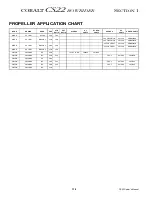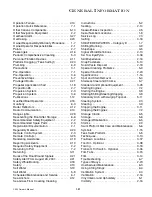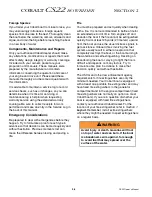
2
-
10
CS22 Owner’s Manual
COBALT
CS22
BOWRIDER
S
ECTION
2
• If you lose power, keep the boat headed into
the waves by using the anchor.
Water Rescue (Man Overboard)
Immediately react to a person that has fallen
overboard. Keep the victim constantly in your sight.
Safely return to the victim as soon as possible.
Throw the person a PFD. Turn the engines off and
help the person into the boat.
Medical Emergency
Be prepared in the event of an emergency. Know
how to use your first aid kit. Be aware of any special
medical conditions of your passengers.
Drowning
React to a drowning victim the same as described
in Water Rescue. Handle victims with care; they
could be injured. If necessary, resuscitate the
victim. Immediately signal for help and keep the
victim warm.
Operation Failure
Have equipment available and be prepared to rig
an emergency steering system in case of an
emergency with the drive units.
If you experience a propulsion, steering or control
failure, immediately turn off the engines. Release
the anchor to prevent drifting. Try to determine the
failure and repair, if possible. Otherwise, call or
signal for assistance.
Distress Signals
Federal law also requires boats 16 ft (4.8 m) and
longer to carry day and night visual distress signals
when operating on coastal waters, the Great Lakes,
territorial seas or those waters directly connected to
them, up to a point where the body of water is less
than two miles wide. Carry several types of
signaling devices to handle a variety of conditions.
Have enough signals onboard to last three days.
Radio Communication
Radio communication is the most important avenue
of receiving and sending information. Use a
VHF/FM radio for short-range communication, and
a single-sideband radio (SSB) for long-range. For
all U.S. waters, the National Weather Service
operates the NOAA Weather Radio (NWR). This
service provides continuous weather information on
the following VHF/FM frequencies:
• 162.400 MHz • 162.500 MHz
• 162.425 MHz • 162.525 MHz
• 162.450 MHz • 162.550 MHz
• 162.475 MHz
Coast Guard Marine Information Stations
• 2670.0 kH • 8765.4 kH
• 4428.7 kH • 13113.2 kH
• 6506.4 kH
It is good practice to periodically monitor the
weather.
VHF-FM Channel 16 and SSB 2182 kHz are
designated for emergency use. Such situations can
be categorized as:
•
Emergency –
“MAYDAY, MAYDAY, MAYDAY”
– Used when
a life or vessel is in imminent danger.
•
Urgency –
“PAN-PAN, PAN-PAN, PAN-PAN”
(pronounced PAHN-PAHN) – Used when a
person or vessel is in some jeopardy less than
indicated by a Mayday call.
•
Safety –
“SECURITY, SECURITY, SECURITY”
(pronounced SAY-CURE-IT-TAY) – Used for
navigational safety or weather warning.
An emergency situation will be hectic and there will
not be time to learn proper radio procedure.
LEARN WHAT TO DO BEFORE YOU NEED TO
DO IT.
NOTICE: Some pyrotechnics are
restricted from use on certain
bodies of water, so check with
local authorities.
Содержание CS22
Страница 2: ...ii CS22 Owner s Manual COBAL T CS22 BOWRIDER ...
Страница 8: ...viii CS22 Owner s Manual COBAL T CS22 BOWRIDER NOTES ...
Страница 60: ...2 30 CS22 Owner s Manual COBAL T CS22 BOWRIDER SECTION 2 NOTES ...
Страница 102: ...4 4 CS22 Owner s Manual COBAL T CS22 BOWRIDER SECTION 4 ...
Страница 124: ...6 10 CS22 Owner s Manual COBAL T CS22 BOWRIDER SECTION 6 NOTES ...
Страница 127: ...CS22 Owner s Manual 7 3 REFERENCE AND FORMS SERVICE LOG Date Hour Reading Service Repairs Performed ...
Страница 132: ...7 8 CS22 Owner s Manual COBAL T CS22 BOWRIDER SECTION 7 NOTES ...
















































